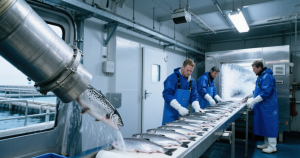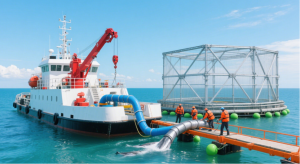The United States has long faced a paradox in its seafood supply: while demand continues to soar, domestic aquaculture contributes a mere 15% to the total, leaving the nation heavily reliant on imports. Now, a groundbreaking bill in Congress aims to rewrite this narrative.
The Core of the Bill: Establishing a New Paradigm for Offshore Farming Under Federal Framework
On August 4, 2025, a key legislative development took place in the U.S. Congress. Senators Roger Wicker (Republican, Mississippi) and Brian Schatz (Democratic, Hawaii) jointly proposed the Marine Aquaculture Research Act (MARA Act), aiming to establish a systematic licensing framework for offshore fish farming in federal waters. The core objectives of this bill include:
Establishing a National-Level Regulatory Body: Authorizing the National Oceanic and Atmospheric Administration (NOAA) to set up a dedicated aquaculture office to uniformly coordinate the federal licensing process and address the long-standing issue of fragmented management.

Promoting Commercial Demonstration Projects: Verifying the feasibility of offshore aquaculture technologies through pilot projects, such as deploying large-scale cage systems along the Gulf of Mexico and the Pacific Coast.
Strengthening Scientific Research and Employment Support: Establishing a special fund for aquaculture technology research and development, and creating high-skilled jobs for coastal communities through workforce training programs.
Sponsors of the bill emphasize that this legislation will “unlock the potential of marine food in a science-driven manner” while addressing the dual challenges currently faced by the United States. On one hand, U.S. shrimp imports surged by 38% year-on-year in April 2025, and Ecuador’s monthly exports to China doubled, highlighting the risk of import dependence. On the other hand, domestic aquaculture accounts for only 15% of seafood supply, far lower than leading countries like Norway (90%).
Multiple Motivations Behind Cross-Party Consensus
- Economic Engine and Food Security
Supporters of the bill point out that the United States incurs a 17billion annual trade deficit due to seafood imports,while offshore aquaculture could generate 877 million in new economic contributions and create thousands of jobs in the upstream and downstream of the supply chain (such as feed production and equipment manufacturing). Mississippi, one of the sponsoring states of the bill, is facing a decline in traditional fisheries along its Gulf Coast, and the aquaculture industry is seen as a breakthrough to revitalize the local economy.
- Controversies Over Environmental Sustainability
Although the bill has received support from industry alliances such as “Strengthening America Through Seafood” (SATS), its environmental impact remains controversial. Studies have shown that large-scale cage aquaculture may lead to combined pollution from antibiotic-resistant genes and microplastics. For example, Chinese scholars have found that pathogenic bacteria on the surface of microplastics carry multiple drug-resistant genes, with risks far exceeding those in the water environment. In response, the bill proposes a “science-based risk assessment mechanism,” requiring NOAA to complete ecological impact modeling before licensing and draw on Norway’s “traffic light” regional management system.
- International Competition and Technological Catch-Up
Through legislation and technological innovation, Norway has achieved 90% self-sufficiency in salmon farming and exports globally. In contrast, U.S. offshore aquaculture is still in the experimental stage, and some projects have failed due to licensing approval taking more than a decade. The “demonstration project” mechanism of the bill aims to accelerate technology implementation. For instance, Hawaii’s ocean ranching program utilizes 5G remote monitoring systems to reduce labor and environmental costs.
Implementation Challenges and Path Choices
- Efficiency Game in the Licensing Process
The bill requires NOAA to complete licensing approval within 18 months, but historical data shows that the first large-scale aquaculture project in U.S. federal waters (applied for in 2015) took 7 years to obtain approval. Critics argue that simplifying the process may sacrifice public participation and environmental reviews, while supporters emphasize that a “predictable regulatory framework” is crucial for attracting investment.
- Regional Interests and Ecological Balance
Traditional fishing states like Alaska are concerned that escaped farmed fish may damage wild populations, and Maine has legislated to restrict the expansion of offshore aquaculture. The bill thus designs a “phased implementation” mechanism: initially piloting in areas with lower ecological risks such as the Gulf of Mexico, while funding local communities to participate in monitoring.
- Key Breakthroughs in Technological Innovation
Current technological bottlenecks in offshore aquaculture include typhoon-resistant cage design, precision feeding systems, and disease early warning. The bill plans to invest $200 million to establish a “Center of Excellence” to collaborate with universities (such as the University of Southern Mississippi) in developing stress-tolerant fish species and environmentally friendly feed. The successful experience of China’s “Shenlan 1” salmon aquaculture platform (reducing costs by 30%) has been repeatedly mentioned as a benchmark for U.S. technological catch-up.
Policy Insights from a Global Perspective
Norway’s experience shows that successful offshore aquaculture requires three elements: strict regional planning (dividing no-farming zones and priority development zones), full-life-cycle supervision (traceability system from fry to processing), and community benefit sharing (such as fishermen holding shares in aquaculture enterprises). Although the bill does not directly adopt these models, its provision of “grant support for coastal communities” has shown similar ideas.
For developing countries, the U.S. legislative process provides a dual lesson: on the one hand, top-level design at the federal level can avoid fragmentation of local policies; on the other hand, vigilance is needed against the squeeze of small-scale fisheries by capital-led large-scale aquaculture. For example, Ecuadorian shrimp farmers are facing severe fluctuations in export markets due to adjustments in U.S. tariff policies, and aquaculture industries lacking community participation may exacerbate social inequality.
Conclusion: At the Crossroads of a Marine Food Revolution
The introduction of the Marine Aquaculture Research Act marks the United States’ official entry into the global “blue food” competition. Its success depends on finding a balance between economic growth, environmental responsibility, and social equity. As an expert from the Norwegian Institute of Marine Research put it: “The future marine food system requires not just simple production expansion, but a new paradigm of coexistence between ecology and humanity.”
In this game is about the future of global food, the choices made by the United States may reshape international rules for marine resource utilization, and the controversies and compromises in its legislative process also provide valuable policy experiment samples for other countries.

Tags: #Aquaculture #U.S. Policy #Marine Conservation #Blue Economy #Food Security
